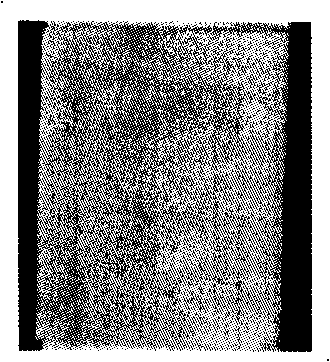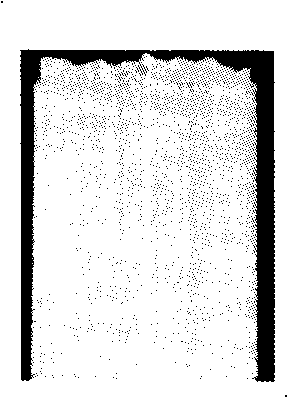Method for finishing fastness silver salt antimicrobial fabric
An antibacterial fabric and anti-discoloration technology, applied in fiber treatment, textiles and papermaking, etc., can solve the problems of unsuitable antibacterial finishing of textiles, restricted application of silver salt antibacterial agents, complex preparation and application processes, etc., and achieve low cost and antibacterial ability Excellent, spillover reduction effect
- Summary
- Abstract
- Description
- Claims
- Application Information
AI Technical Summary
Problems solved by technology
Method used
Image
Examples
Embodiment 1
[0036] Step 1, the fabric is dipped and rolled twice in the aqueous solution prepared by mixing the water glass with a modulus range of 2.4, a mass percent concentration of 4% and a mass percent concentration of 10% saturated ammonium citrate, and the strip of the fabric after dipping The liquid rate is 70%, pre-baked at 80°C for 3 minutes, baked at 120°C for 2 minutes, and washed with water.
[0037] Step 2, the fabric is soaked at room temperature for 20 minutes in a silver nitrate aqueous solution (0.005% by mass) with a bath ratio of 40:1, and baked at 80° C. for 3 minutes
[0038] Step 3. Soak the fabric in an aqueous sodium thiosulfate solution (0.02% by mass) with a bath ratio of 40:1 for 20 minutes, pre-bake at 80° C. for 3 minutes, and bake at 120° C. for 3 minutes.
Embodiment 2
[0040] Step 1, the fabric is dipped and rolled twice in the aqueous solution prepared by mixing the water glass with a modulus range of 2.4, a mass percentage concentration of 15% and a mass percentage concentration of 3% saturated ammonium maleate, and the impregnation of the fabric The liquid-carrying rate is 80%, pre-baked at 80°C for 3 minutes, baked at 120°C for 6 minutes, and washed with water.
[0041] Step 2. Soak the fabric in silver citrate aqueous solution (0.10% by mass) with a bath ratio of 40:1 at room temperature for 60 minutes, and bake at 80° C. for 6 minutes.
[0042] Step 3. Soak the fabric in an aqueous solution of potassium thiosulfate (0.1% by mass) with a bath ratio of 40:1 for 60 minutes, pre-bake at 80° C. for 3 minutes, and bake at 120° C. for 6 minutes.
Embodiment 3
[0044] Step 1, the fabric is the mixture of ammonium formate and ammonium acetate and the polyethylene glycol that the mass percent concentration is 0.1% in the modulus range of 2.4, the mass percent concentration is 4% water glass, the mass percent concentration is 10% (molecular weight is 100) in the prepared aqueous solution, dipping and rolling twice, the liquid carrying rate is 70%, pre-bake at 80° C. for 3 minutes, bake at 120° C. for 2 minutes, and then wash with water.
[0045] Step 2, the fabric is dipped and rolled twice in the mixture aqueous solution (mass percentage concentration is 0.02%) of potassium thiosulfate and ammonium thiosulfate, at normal temperature, liquid carrying rate is 70%, after 5 minutes prebaking at 80 ℃, 120 Bake at ℃ for 2 minutes, wash with water.
[0046]Step 3, the fabric is dipped and rolled twice in the aqueous solution of the mixture of silver benzoate and silver fluoride (mass percentage concentration is 0.005%), at normal temperature,...
PUM
 Login to View More
Login to View More Abstract
Description
Claims
Application Information
 Login to View More
Login to View More - R&D
- Intellectual Property
- Life Sciences
- Materials
- Tech Scout
- Unparalleled Data Quality
- Higher Quality Content
- 60% Fewer Hallucinations
Browse by: Latest US Patents, China's latest patents, Technical Efficacy Thesaurus, Application Domain, Technology Topic, Popular Technical Reports.
© 2025 PatSnap. All rights reserved.Legal|Privacy policy|Modern Slavery Act Transparency Statement|Sitemap|About US| Contact US: help@patsnap.com



